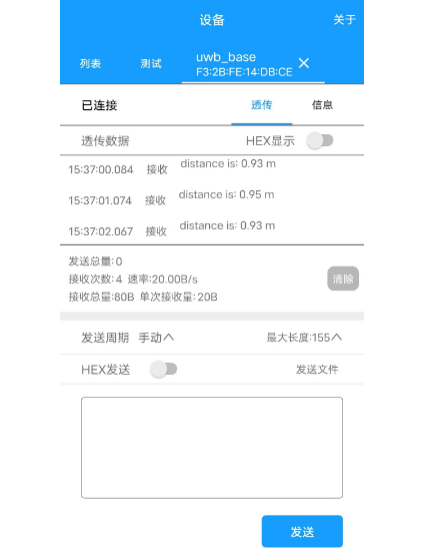Under the same conditions, 2.4GHz has better penetration capability than 5GHz (shorter wavelength results in stronger penetration ability).
They can be enabled and operational simultaneously. The MS11SF11 module only supports one RF channel, with BLE and Wi-Fi sharing this channel.
They cannot transmit and receive data simultaneously; therefore, data packets are transmitted and received using a time-division multiplexing method.
We have currently implemented only one-to-one distance measurement in the UWB demo, and it cannot achieve positioning.
Please refer to the documentation.
1. Open the project: uwb demo\uwb-ranging\examples\uwb_demo\Project\s140\ses
2. The default program is compiled and burned to a device, which will broadcast uwb_base
3. In main.c, change this position to 1, that is, change to tag mode, after compiling and burning to another device, it will broadcast uwb_tag.
Ensure that both devices are powered up, then you can view the ranging results through the serial port, or you can use the app Minew Serial Assistant to connect the devices and see the ranging output. If you use the serial port to view the results of the distance measurement, TX pin is: P0.08, RX pin is P0.06
Ensure that both devices are powered up, then you can view the ranging results through the serial port, or you can use the app Minew Serial Assistant to connect the devices and see the ranging output. If you use the serial port to view the results of the distance measurement, TX pin is: P0.08, RX pin is P0.06

The transmission power of UWB is set according to the recommended values in the specification sheet, and there is no specific value in dB.Through radiation testing with a spectrum analyzer, the approximate transmission power is -10 dBm.
OTA functionality is possible, but the code size needs to be considered. If customers develop their own code, the S112 protocol stack occupies 100k flash, the bootloader occupies 24k, leaving 68k to be shared. Therefore, the code size must not exceed 34k.
Multiple master-slave communication involves one-to-many devices, whereas mesh networking involves many-to-many communication. Multiple master-slave configurations adhere to standard BLE connection methods, while mesh networking is built on BLE broadcasting protocols.
We have MAC addresses generated based on the current date for some samples. MAC addresses starting with AC:23:3F were used for previous production runs, but those addresses have been exhausted. Current MAC addresses start with C3:00.